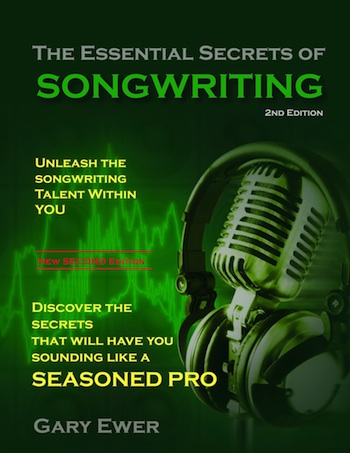 The eBook, “The Essential Secrets of Songwriting,” is a great way for songwriters, whether novice or experienced, to strengthen their songwriting technique. It clears up the mystery of why good songs are so successful, and brings joy back to songwriting.
The eBook, “The Essential Secrets of Songwriting,” is a great way for songwriters, whether novice or experienced, to strengthen their songwriting technique. It clears up the mystery of why good songs are so successful, and brings joy back to songwriting.
The following is an excerpt from Chapter 4: Harmony. That chapter looks at four vital aspects of how chord progressions work: 1) The basics; 2) How one chord moves to another; 3) Integrating balance when building a longer progression; and 4) Expanding your chord vocabulary. This excerpt discusses the important concept of harmonic rhythm:
Balance is a bit of an abstract concept. It would be ludicrous to say that balance, or any other concept, for that matter, is a constant value. Nothing in the arts works that way. Nonetheless, music in the pop song world usually works by providing certain perceivable and predictable patterns to the listener. The patterns I am talking about here are not necessarily rhythmic patterns, as we usually mean when we use that term. I am speaking of the frequency and pacing of the chord changes. This is known as the harmonic rhythm of the song. It leads us to our third principle of chord progressions:
THERE SHOULD BE A PERCEIVABLE AND SOMEWHAT PREDICTABLE PATTERN TO THE FREQUENCY OF CHORD CHANGES.
Slow harmonic rhythm, combined with a relaxed instrumental treatment, gives a pensive, meditative quality to the music. But slow harmonic rhythm combined with an energetic driving pulse gives the music a gritty, determined air. Some songs use a combination. James Taylor’s “Your Smiling Face” changes chords on every beat for two bars, then switches to chords that last for two beats. This is the basic pattern for much of the song.
Changing the harmonic rhythm within a song should not be done haphazardly. Songs that move from a slower to a faster harmonic rhythm generally gain energy. So do that if it’s the effect you are going for. That gained energy is sometimes difficult to dissipate within a section, so increasing the frequency of your chord changes is best achieved by introducing the effect in a new, higher energy section such as a chorus or a bridge.
Tempo and Harmonic Rhythm
There are very few “rules” in songwriting. As soon as you mention a rule, you’ve got a list of a dozen or more songs that don’t do that! Nonetheless, that’s not to say there aren’t some basic guidelines you should follow. And when it comes to chords, and the number of chords you should be using, remember this basic principle: The faster the tempo, the slower the harmonic rhythm.
It’s impossible to state a rule about this, but for most songs of moderate tempo, you’ll find that holding chords for 4 to 8 beats usually works well. And for obvious reasons, this guideline is similar to the advice given earlier regarding how long a progression should be. For faster tempos, give the listener a chance to let chords sink in.
At issue is the “feel” of your song; combining fast tempos with quick chord changes can add a panicky atmosphere to your song. No problem, if you’re looking for that frantic feel. But if you’re simply wanting to build energy by way of a sizzling tempo, you’ll find that allowing more beats before actually changing to the next chord allows you to build energy without also making the music sound frenzied or panic-stricken.
“The Essential Secrets of Songwriting” is part of the 6-eBook Bundle for songwriters, along with a seventh eBook, “From Amateur to Ace: Writing Songs Like a Pro.” The entire bundle of seven eBooks is available for immediate download at a bundle price of $37 (regular price $95.70). Read more.
Gary Ewer is the author of “Beating Songwriter’s Block: Jump-Start Your Words and Music”, available through Amazon.com, Barnes & Noble, and Hal Leonard Books.










Pingback: Tame Impala – Feels like we only go backwards | One Minute Song
Reblogged this on I Write The Music.
Pingback: Interesting Links For Musicians and Songwritiers – May 14, 2014 | Creative Music | Inspiring Musical Creativity